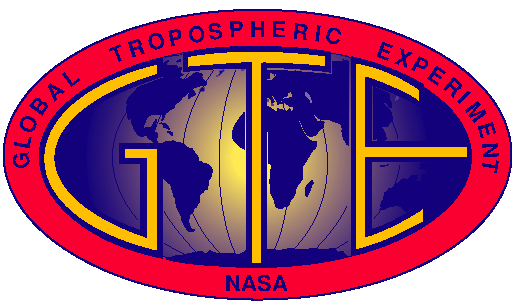|
|||||
|
|||||
GTE Expeditions |
![[GTE World Map]](../../../images/JH-GTE_Missions.gif)
Flight tracks and selected data can be viewed for missions:
PEM West A, PEM
West B, PEM-Tropics A, PEM-Tropics
B,
TRACE-A and TRACE-P
Descriptions of each mission are available from GTE
Field Missions.
 Click here for the latest Tropospheric Chemistry Campaigns Map including SONEX, INTEX-NA and INTEX-B missions
Click here for the latest Tropospheric Chemistry Campaigns Map including SONEX, INTEX-NA and INTEX-B missions
Please visit http://www-air.larc.nasa.gov for information on INTEX-NA and INTEX-B missions.
GTE Expeditions
The GTE was initiated as a series of global airborne measurement campaigns to study the impact that humans are having on the global troposphere. The map above shows the geographical regions for the GTE campaigns, and provides a link to more detailed infromation on each. The Chemical Instrumentation Test and Evaluation (CITE) experiments were initiated to evaluate our ability to measure critical tropospheric species; the field studies known as Atmospheric Boundary Layer Experiment (ABLE) have been conducted to study major ecosystems that are known to exert a major influence on global chemistry and, in some cases, are undergoing profound changes; and the impact of long range transport of continental emissions, natural and anthropogenic, have been studied through focused missions such as the Transport and Chemistry near the Equator in the Atlantic (TRACE-A) experiments and Pacific Exploratory Missions (PEM) A and B, and PEM-Tropics.
Instrument Development: CITE -Expeditions
Three CITE mission have been conducted as part of GTE. The CITE-1, consisting of a ground- based (1983), and 2 separate airborne campaigns (1983 and 1984), evaluated instrumentation for measuring carbon monoxide (CO), nitric oxide (NO), and the hydroxyl radical (OH). The CITE- 2 mission focused on intercomparison of techniques for measuring nitrogen dioxide (NO2), nitric acid (HNO3) and peroxyacetylnitrate (PAN), as well as a re-evaluation of NO techniques. The CITE-3 mission focused on intercomparison of techniques to measure key sulfate species sulfur dioxide (SO2), dimethylsulfide (DMS), hydrogen sulfide (H2S), carbonyl sulfide (COS), and carbon disulfide (CS2).
Biosphere/Atmosphere Exchange: ABLE-Expeditions
Three ABLE campaigns have been conducted thus far. The ABLE-1, conducted in 1984 from Barbados, focused on the chemistry and transport processed over the tropical Atlantic ocean and the rain forest of French Guyana. The ABLE-2, based in Manaus, Brazil, focused on the chemistry and transport over the Amazon Rain Forest during the dry season of 1985 ( ABLE-2A) and during the wet season of 1987 ( ABLE-2B). The ABLE-3 mission, also conducted in 2- phases, focused on the chemistry in the northern latitude and the Arctic tundra as a source/sink of methane (CH4), ozone (O3), and CO. The first phase, ABLE-3A was conducted in 1988 from bases in Point Barrow and Bethel, Alaska. The second phase, ABLE-3B was conducted in 1990, from bases at North Bay and Goose Bay , Canada and a major ground site in Schefferville, Canada.
Long Range Transport: TRACE-A, TRACE-P and PEM-West Expeditions
Within GTE, two field studies have been conducted which focused on the impact of long range transport of trace gases on the chemistry of the free troposphere. The first of these, the Pacific Exploratory Mission-West (PEM-West) focused on characterizing the impact of the natural and anthropogenic emission from the Asian continent on the chemistry of the troposphere over the western North Pacific ocean. PEM-West encompassed two field campaigns during the two major contrasting meteorological regimes in the north western pacific. The first, PEM-West(A), minimum out-flow from the Asian continent. PEM-West(B) was conducted during the spring of 1994, a period of maximum outflow from the Asian continent. Manuscripts describing the results from PEM-West(A) are in review. Measurements from PEM-West(B) are currently being validated.
The second experiment in this series of GTE missions was the Transport
and Chemistry near the Equator in the Atlantic (TRACE-A) experiment,
conducted in September/October 1992 to investigate the distribution of
atmospheric trace gases over the tropical south Atlantic. This portion of
the Atlantic troposphere is coupled by atmospheric-transport of emissions
from both South America and southern Africa. The TRACE-A experiment was
conducted to study the impact of emission from these two continents on a
seasonal enhancement of tropospheric O3 over a large region of
the South Atlantic ocean off the coast of Brazil and southern Africa. The
Objectives of TRACE-A focussed on determining the relative importance of
natural versus amthropogenic emmision/processes on the formatin of this O3
enhancement. TRACE-P, conducted in March/April 2001, has as it's major objectives to 1) determine the
chemical composition of the Asian outflow over the western Pacific in spring in order to understand and quantify the export of
chemically and radiatively important gases and aerosols, and their precursors, from the Asian continent and to 2) determine the
chemical evolution of the Asian outflow over the western Pacific in spring and to understand the ensemble of processes that
control the evolution.







